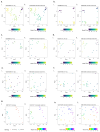Improving Replication in Endometrial Omics: Understanding the Influence of the Menstrual Cycle
- PMID: 39859570
- PMCID: PMC11766126
- DOI: 10.3390/ijms26020857
Improving Replication in Endometrial Omics: Understanding the Influence of the Menstrual Cycle
Abstract
The dynamic nature of human endometrial tissue presents unique challenges in analysis. Despite extensive research into endometrial disorders such as endometriosis and infertility, recent systematic reviews have highlighted concerning issues with the reproducibility of omics studies attempting to identify biomarkers. This review examines factors contributing to poor reproducibility in endometrial omics research. Hormonal fluctuations in the menstrual cycle lead to widespread molecular changes in the endometrium, most notably in gene expression profiles. In this review, we examine the variability in omics data due to the menstrual cycle and highlight the importance of accurate menstrual cycle dating for effective statistical modelling. The current standards of endometrial dating lack precision and we make the case for using molecular-based modelling methods to estimate menstrual cycle time for endometrium tissue samples. Additionally, we discuss statistical considerations such as confounding and interaction effects, as well as the importance of recording the detailed and accurate clinical information of patients. By addressing these methodological challenges, we aim to establish more robust and reproducible research practises, increasing the reliability of endometrial omics research and biomarker discovery.
Keywords: endometrium; experimental design; gene expression; omics.
Conflict of interest statement
The endest method described in this review is the subject of a patent filed at the Australian Patent Office (21/6/23 (PCT/AU2023/050559)) by the University of Melbourne with J.C. and P.A.R. as inventors.
Figures





Similar articles
-
The influence of menstrual cycle and endometriosis on endometrial methylome.Clin Epigenetics. 2016 Jan 12;8:2. doi: 10.1186/s13148-015-0168-z. eCollection 2016. Clin Epigenetics. 2016. PMID: 26759613 Free PMC article.
-
The expression pattern of endometrial receptivity genes is desynchronized between endometrium and matched endometriomas.Reprod Biomed Online. 2022 Oct;45(4):713-720. doi: 10.1016/j.rbmo.2022.05.028. Epub 2022 Jun 9. Reprod Biomed Online. 2022. PMID: 35927210
-
The genetic regulation of transcription in human endometrial tissue.Hum Reprod. 2017 Apr 1;32(4):893-904. doi: 10.1093/humrep/dex006. Hum Reprod. 2017. PMID: 28177073
-
Biomarkers in endometriosis: challenges and opportunities.Fertil Steril. 2017 Mar;107(3):523-532. doi: 10.1016/j.fertnstert.2017.01.009. Epub 2017 Feb 8. Fertil Steril. 2017. PMID: 28189296 Review.
-
Epigenetic regulation of endometrium during the menstrual cycle.Mol Hum Reprod. 2010 May;16(5):297-310. doi: 10.1093/molehr/gaq010. Epub 2010 Feb 5. Mol Hum Reprod. 2010. PMID: 20139117 Review.
References
Publication types
MeSH terms
Substances
Grants and funding
LinkOut - more resources
Full Text Sources
Medical

